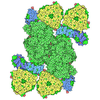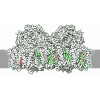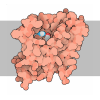[English] 日本語
 Yorodumi
Yorodumi- PDB-8ydm: Cryo-EM structure of CaRC-LH complex from Chloroflexus aurantiacus -
+ Open data
Open data
- Basic information
Basic information
| Entry | Database: PDB / ID: 8ydm | ||||||
|---|---|---|---|---|---|---|---|
| Title | Cryo-EM structure of CaRC-LH complex from Chloroflexus aurantiacus | ||||||
 Components Components |
| ||||||
 Keywords Keywords | PHOTOSYNTHESIS | ||||||
| Function / homology |  Function and homology information Function and homology informationorganelle inner membrane / plasma membrane light-harvesting complex / bacteriochlorophyll binding / photosystem II / photosynthetic electron transport in photosystem II / : / photosynthesis, light reaction / periplasmic space / electron transfer activity / iron ion binding ...organelle inner membrane / plasma membrane light-harvesting complex / bacteriochlorophyll binding / photosystem II / photosynthetic electron transport in photosystem II / : / photosynthesis, light reaction / periplasmic space / electron transfer activity / iron ion binding / heme binding / metal ion binding / plasma membrane Similarity search - Function | ||||||
| Biological species |   Chloroflexus aurantiacus J-10-fl (bacteria) Chloroflexus aurantiacus J-10-fl (bacteria) | ||||||
| Method | ELECTRON MICROSCOPY / single particle reconstruction / cryo EM / Resolution: 3.05 Å | ||||||
 Authors Authors | Guoqiang, H. / Shishang, D. | ||||||
| Funding support |  China, 1items China, 1items
| ||||||
 Citation Citation |  Journal: J Integr Plant Biol / Year: 2025 Journal: J Integr Plant Biol / Year: 2025Title: Cryo-EM structure of a minimal reaction center-light-harvesting complex from the phototrophic bacterium Chloroflexus aurantiacus. Authors: Guoqiang Huang / Shishang Dong / Lin Ma / Lin Li / Jinxin Ju / Mei-Jiao Wang / Jian-Ping Zhang / Sen-Fang Sui / Xiaochun Qin /  Abstract: Photosynthetic organisms have developed various light-harvesting antenna systems to capture light and transfer energy to reaction centers (RCs). Simultaneous utilization of the integral membrane ...Photosynthetic organisms have developed various light-harvesting antenna systems to capture light and transfer energy to reaction centers (RCs). Simultaneous utilization of the integral membrane light-harvesting antenna (LH complex) and the extrinsic antenna (chlorosomes) makes the phototrophic bacterium Chloroflexus (Cfx.) aurantiacus an ideal model for studying filamentous anoxygenic phototrophs (FAPs). Here, we determined the structure of a minimal RC-LH photocomplex from Cfx. aurantiacus J-10-fl (CaRC-LH) at 3.05-Å resolution. The CaRC-LH binds only to seven LH subunits, which form a crescent-shaped antenna surrounding the movable menaquinone-10 (Q) binding site of CaRC. In this complex with minimal LH units, an extra antenna is required to ensure sufficient light-gathering, providing a clear explanation for the presence of chlorosomes in Cfx. aurantiacus. More importantly, the semicircle of the antenna represents a novel RC-LH assembly pattern. Our structure provides a basis for understanding the existence of chlorosomes in Cfx. aurantiacus and the possible assembly pattern of RC-LH. | ||||||
| History |
|
- Structure visualization
Structure visualization
| Structure viewer | Molecule:  Molmil Molmil Jmol/JSmol Jmol/JSmol |
|---|
- Downloads & links
Downloads & links
- Download
Download
| PDBx/mmCIF format |  8ydm.cif.gz 8ydm.cif.gz | 394.5 KB | Display |  PDBx/mmCIF format PDBx/mmCIF format |
|---|---|---|---|---|
| PDB format |  pdb8ydm.ent.gz pdb8ydm.ent.gz | 325 KB | Display |  PDB format PDB format |
| PDBx/mmJSON format |  8ydm.json.gz 8ydm.json.gz | Tree view |  PDBx/mmJSON format PDBx/mmJSON format | |
| Others |  Other downloads Other downloads |
-Validation report
| Summary document |  8ydm_validation.pdf.gz 8ydm_validation.pdf.gz | 4.3 MB | Display |  wwPDB validaton report wwPDB validaton report |
|---|---|---|---|---|
| Full document |  8ydm_full_validation.pdf.gz 8ydm_full_validation.pdf.gz | 4.5 MB | Display | |
| Data in XML |  8ydm_validation.xml.gz 8ydm_validation.xml.gz | 105.9 KB | Display | |
| Data in CIF |  8ydm_validation.cif.gz 8ydm_validation.cif.gz | 128.3 KB | Display | |
| Arichive directory |  https://data.pdbj.org/pub/pdb/validation_reports/yd/8ydm https://data.pdbj.org/pub/pdb/validation_reports/yd/8ydm ftp://data.pdbj.org/pub/pdb/validation_reports/yd/8ydm ftp://data.pdbj.org/pub/pdb/validation_reports/yd/8ydm | HTTPS FTP |
-Related structure data
| Related structure data |  39177MC M: map data used to model this data C: citing same article ( |
|---|---|
| Similar structure data | Similarity search - Function & homology  F&H Search F&H Search |
- Links
Links
- Assembly
Assembly
| Deposited unit | 
|
|---|---|
| 1 |
|
- Components
Components
-Light-harvesting protein B-808/866 ... , 2 types, 14 molecules ADFHJOQBEGIKPR
| #1: Protein | Mass: 6202.317 Da / Num. of mol.: 7 / Source method: isolated from a natural source Source: (natural)   Chloroflexus aurantiacus J-10-fl (bacteria) Chloroflexus aurantiacus J-10-fl (bacteria)Strain: J-10-fl / References: UniProt: P07503 #2: Protein | Mass: 6327.378 Da / Num. of mol.: 7 / Source method: isolated from a natural source Source: (natural)   Chloroflexus aurantiacus J-10-fl (bacteria) Chloroflexus aurantiacus J-10-fl (bacteria)Strain: J-10-fl / References: UniProt: P09927 |
|---|
-Protein , 2 types, 2 molecules CN
| #3: Protein | Mass: 45625.227 Da / Num. of mol.: 1 / Source method: isolated from a natural source Source: (natural)   Chloroflexus aurantiacus J-10-fl (bacteria) Chloroflexus aurantiacus J-10-fl (bacteria)Strain: J-10-fl / References: UniProt: P33325 |
|---|---|
| #6: Protein | Mass: 6865.124 Da / Num. of mol.: 1 / Source method: isolated from a natural source Source: (natural)   Chloroflexus aurantiacus J-10-fl (bacteria) Chloroflexus aurantiacus J-10-fl (bacteria) |
-Reaction center protein ... , 2 types, 2 molecules LM
| #4: Protein | Mass: 35173.309 Da / Num. of mol.: 1 / Source method: isolated from a natural source Source: (natural)   Chloroflexus aurantiacus J-10-fl (bacteria) Chloroflexus aurantiacus J-10-fl (bacteria)Strain: J-10-fl / References: UniProt: P11695 |
|---|---|
| #5: Protein | Mass: 34987.316 Da / Num. of mol.: 1 / Source method: isolated from a natural source Source: (natural)   Chloroflexus aurantiacus J-10-fl (bacteria) Chloroflexus aurantiacus J-10-fl (bacteria)Strain: J-10-fl / References: UniProt: P09438 |
-Non-polymers , 7 types, 48 molecules 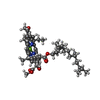
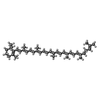
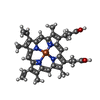
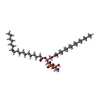

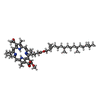







| #7: Chemical | ChemComp-BCL / #8: Chemical | ChemComp-U4Z / #9: Chemical | ChemComp-HEM / #10: Chemical | ChemComp-PGV / ( | #11: Chemical | #12: Chemical | #13: Chemical | ChemComp-MN / | |
|---|
-Details
| Has ligand of interest | Y |
|---|---|
| Has protein modification | N |
-Experimental details
-Experiment
| Experiment | Method: ELECTRON MICROSCOPY |
|---|---|
| EM experiment | Aggregation state: PARTICLE / 3D reconstruction method: single particle reconstruction |
- Sample preparation
Sample preparation
| Component | Name: Cryo-EM structure of CaRC-LH complex from Chloroflexus aurantiacus Type: COMPLEX / Entity ID: #1-#6 / Source: NATURAL |
|---|---|
| Source (natural) | Organism:   Chloroflexus aurantiacus J-10-fl (bacteria) Chloroflexus aurantiacus J-10-fl (bacteria) |
| Buffer solution | pH: 7.6 |
| Specimen | Embedding applied: NO / Shadowing applied: NO / Staining applied: NO / Vitrification applied: YES |
| Vitrification | Instrument: FEI VITROBOT MARK IV / Cryogen name: ETHANE / Humidity: 100 % / Chamber temperature: 281.15 K |
- Electron microscopy imaging
Electron microscopy imaging
| Experimental equipment |  Model: Titan Krios / Image courtesy: FEI Company |
|---|---|
| Microscopy | Model: FEI TITAN KRIOS |
| Electron gun | Electron source:  FIELD EMISSION GUN / Accelerating voltage: 300 kV / Illumination mode: FLOOD BEAM FIELD EMISSION GUN / Accelerating voltage: 300 kV / Illumination mode: FLOOD BEAM |
| Electron lens | Mode: BRIGHT FIELD / Nominal defocus max: 1500 nm / Nominal defocus min: 1000 nm |
| Image recording | Electron dose: 50 e/Å2 / Film or detector model: GATAN K3 (6k x 4k) |
- Processing
Processing
| CTF correction | Type: NONE |
|---|---|
| 3D reconstruction | Resolution: 3.05 Å / Num. of particles: 36181 / Symmetry type: POINT |
| Refinement | Highest resolution: 3.05 Å |
 Movie
Movie Controller
Controller



 PDBj
PDBj
